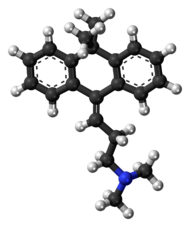Melitracen (brand names Melixeran, Trausabun) is a tricyclic antidepressant (TCA), for the treatment of depression and anxiety.[1][2][3][4] In addition to single drug preparations, it is also available as Deanxit, marketed by Lundbeck, a combination product containing both melitracen and flupentixol.[5][6][7][8]
 | |
 | |
| Clinical data | |
|---|---|
| Trade names | Adaptol, Dixeran, Melixeran, Thymeol, Trausabun |
| AHFS/Drugs.com | International Drug Names |
| Routes of administration | Oral, intramuscular injection |
| ATC code | |
| Legal status | |
| Legal status |
|
| Identifiers | |
| |
| CAS Number | |
| PubChem CID | |
| ChemSpider | |
| UNII | |
| KEGG | |
| ChEMBL | |
| CompTox Dashboard (EPA) | |
| ECHA InfoCard | 100.023.507 |
| Chemical and physical data | |
| Formula | C21H25N |
| Molar mass | 291.438 g·mol−1 |
| 3D model (JSmol) | |
| |
| |
| | |
The pharmacology of melitracen has not been properly investigated and is largely unknown, but it is likely to act in a similar manner to other TCAs. Indeed, melitracen is reported to have imipramine and amitriptyline-like effects and efficacy against depression and anxiety, though with improved tolerability and a somewhat faster onset of action.[9][10]
See also
editReferences
edit- ^ Swiss Pharmaceutical Society (2000). Index Nominum 2000: International Drug Directory (Book with CD-ROM). Boca Raton: Medpharm Scientific Publishers. ISBN 3-88763-075-0.
- ^ Rhodes PH (1996). Dictionary of organic compounds. London: Chapman & Hall. ISBN 0-412-54090-8.
- ^ O'Neil MJ (2001). The Merck index: an encyclopedia of chemicals, drugs, and biologicals. Rahway, NJ: Merck Research Laboratories. ISBN 0-911910-13-1.
- ^ Holenz J, Díaz JL, Buschmann H (2007). "Marketed Drugs and Drugs in DevelopmentVela". In JM, Buschmann H, Holenz J, Párraga A, Torrens A (eds.). Antidepressants, Antipsychotics, Anxiolytics: From Chemistry and Pharmacology to Clinical Application. Weinheim: Wiley-VCH. ISBN 978-3-527-31058-6.
- ^ Muller NF, Dessing RP (1998). European Drug Index (4th ed.). Boca Raton: CRC Press. ISBN 3-7692-2114-1.
- ^ Van Moffaert M, Dierick M, De Meulemeester F, Vereecken A (1983). "Treatment of depressive anxiety states associated with psychosomatic symptoms. A double-blind multicentre clinical study: mianserin versus melitracen-flupentixol". Acta Psychiatrica Belgica. 83 (5): 525–539. PMID 6670581.
- ^ Bin Yaacob H (April 1985). "Flupenthixol and Melitracen in the management of trigeminal neuralgia". Dental Journal of Malaysia. 8 (2): 37–38. PMID 3917005.
- ^ Hashash JG, Abdul-Baki H, Azar C, Elhajj II, El Zahabi L, Chaar HF, Sharara AI (June 2008). "Clinical trial: a randomized controlled cross-over study of flupenthixol + melitracen in functional dyspepsia". Alimentary Pharmacology & Therapeutics. 27 (11): 1148–1155. doi:10.1111/j.1365-2036.2008.03677.x. PMID 18331614. S2CID 40714136.
- ^ Aronson JK (2008). Meyler's Side Effects of Psychiatric Drugs (Meylers Side Effects). Amsterdam: Elsevier Science. ISBN 978-0-444-53266-4.
- ^ Krapcho J (1970). "Antidepressives and Stimulants". Annual Reports in Medicinal Chemistry. Vol. 5. Boston: Academic Press. ISBN 0-12-040505-9.